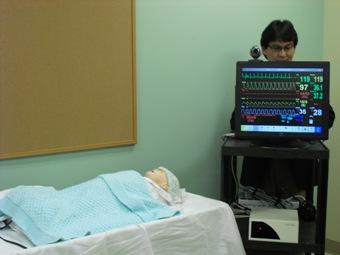
Section Branding
Header Content
Virtual Patient Lab Moves Medicine Forward
Primary Content

A commercial pilot is not allowed to get behind the controls of a passenger jet without spending time on a simulator. But, when a medical resident puts in a breathing tube for the first time they’re doing it on a live patient. But times are changing. The Medical Center of Central Georgia’s new simulation lab gives nurses and doctors the chance to make mistakes and nobody gets hurt.
“Right now you can feel a good pulse…I can make the pulse weak……..”
Dr. Rogelio Dela Cruz stands over baby Zoe who’s in respiratory distress. Fortunately the baby isn’t real. She’s part of the hospital’s new simulation laboratory. Zoe has a pulse, responds to medication, and CPR.
“It will lessen mistakes. It will improve resuscitation time. It will basically improve care which is most important.”
Dela Cruz says nurses and doctors providing that care will be more prepared when they encounter real patients.
The simulators run the gamut from the very high tech baby Zoe to less complicated rubber models of body parts. Nurse Dawn Cole turns over a lifelike torso exposing deep wounds. She says showing this to nursing students and residents will prepare them for things they’ll see firsthand.
“When you hear people talk about pressure ulcers this is what it looks like. This is real gooey stuff. It’ll go way deep. What people have to realize is it may look like this on the outside, but in a day or two it’s gonna look like this.”
Increasingly hospitals across the United States are adding simulation labs. The Department of Veteran’s Affairs just announced simulation centers would be part of their long-range plans to improve patient care.
Kristin Collier is a third year surgical resident at the Medical Center. She plans to return to her hometown of Americus to practice. She says the laparoscopic simulators will help surgeons improve their dexterity.
“This as you can imagine would be the patient’s abdomen or belly where we would make the incisions or place our instruments. When you do laparoscopic surgery what you use is basically a TV camera is how I explain it to patients. So you can see this is as if we are looking inside the patient’s abdomen.”
Collier says before the simulators medical residents would spend long hours observing before they were allowed to work on real patients.
In another room nurses surround the bedside of I-Stan who’s having a seizure. (Nat sound) His room looks just like the ER where many of them work. The team springs into action.
“Just pull your ACLS. Your patient’s in VTAC, what do you need to know? Do you want to defibrillate him? Yeah. How much. How many juhls?.....
Dr. Marcia Hutchison is in charge of the sim lab. She says after Stan is stable the team will go over what just happened.
“There is the time to practice a specific patient situation and then to debrief and look at and say as a team we could have done better for the patient, so next time when we’re in the ICU in a real situation we’ll try out the things we learned in the simulator.”
Hutchison says doing it better will save lives and prevent mistakes. The lab was paid for by a grant from the hospital’s malpractice insurance carrier.
Tags: Medical Center of Central Georgia, medical simulators, advances in medicine, hospital patient safety
